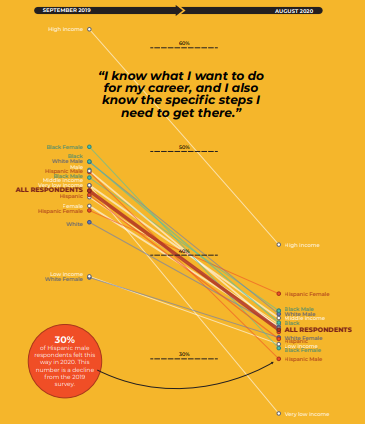This blog series examines trends in state uses of federal stimulus funding for Career Technical Education (CTE). Stimulus funds were appropriated for emergency relief related to the coronavirus pandemic through the federal Coronavirus Aid, Relief and Economic Security (CARES) Act; the Coronavirus Response and Relief Supplemental Appropriations Act (CRRSAA); and the American Rescue Plan (ARP) Act. The five major stimulus funding streams for states and educational institutions include the Coronavirus Relief Fund (CRF), the Elementary and Secondary School Emergency Relief (ESSER) Fund, the Governor’s Emergency Education Relief (GEER) Fund, the Higher Education Emergency Relief Fund (HEERF), and Coronavirus State and Local Fiscal Recovery Funds.
![]() CTE program quality is key for ensuring that learners have access to necessary skills and competencies, meaningful experiential learning opportunities and strong career pathways. Alignment across workforce development systems and both secondary and postsecondary education institutions is essential for connecting learners and employers, as well as promoting experiential and work-based learning opportunities. As states continue to adapt to the challenges posed by the coronavirus pandemic, many are focusing on program quality and investing federal relief funds to strengthen industry alignment and work-based learning initiatives.
CTE program quality is key for ensuring that learners have access to necessary skills and competencies, meaningful experiential learning opportunities and strong career pathways. Alignment across workforce development systems and both secondary and postsecondary education institutions is essential for connecting learners and employers, as well as promoting experiential and work-based learning opportunities. As states continue to adapt to the challenges posed by the coronavirus pandemic, many are focusing on program quality and investing federal relief funds to strengthen industry alignment and work-based learning initiatives.
Some states have already directed federal relief funding to align CTE programs to industry needs and high-skill, high-wage, in-demand jobs. Florida made a $35 million GEER allocation for the state Department of Education to partner with state and technical colleges to expand and improve short-term programs leading to in-demand technical certificates, career certificates and industry-recognized certifications. Through providing additional resources to these critical CTE programs, the state hopes to “reimagine its postsecondary CTE offerings as a mechanism for economic and social mobility.” Florida made an additional $2.5 million GEER investment to develop the Pathway to Job Market Dashboard, an online platform to compile and centralize data on CTE programs across the state. The dashboard will provide an accessible, comprehensive view of CTE program performance and alignment to labor market needs.
Massachusetts directed $10.4 million in CRF funding to expand workforce partnerships with employers in the state’s target sectors. The investment will create aligned training-employment pathways statewide. The state also made an additional $300,000 CRF allocation to expand a project to transform career/vocational technical high schools into Career Technical Institutes that also serve adult learners. These Institutes will run three shifts a day and train 20,000 new workers over four years in technical fields and skilled trades. The CRF funds were used to supplement the $8.4 million state investment to expand skills training and align programs to industry needs.
Other states are prioritizing expanding high-quality work-based learning opportunities that connect learners with employers and industry. Delaware invested $8.3 million in ARP state fiscal recovery funds as part of a public-private partnership to expand the Delaware Pathways program, which provides rigorous, industry-aligned career pathway opportunities for high school students. The funding will allow the program to reach over 80 percent of high school learners in the state, as well as over 6,000 new middle school learners. Support will be targeted for workforce development and “earn and learn” apprenticeship programs in high-growth, high-wage target industries such as health care, engineering, finance and information technology.
Iowa made a $10 million CRF allocation to create two Registered Apprenticeship grant opportunities. Apprenticeships follow an employer-driven, “earn and learn” model that connects classroom learning with on-the-job experience and culminates in an industry-recognized credential. One grant opportunity is available for high schools, nonprofit organizations and small businesses, while the other is open to postsecondary institutions and healthcare employers. Grants can be used to purchase equipment or instructional materials to create or expand apprenticeship programs that also provide for online learning.
As states look to education and workforce development as avenues for mitigating the effects of the pandemic, coronavirus relief funds provide a key opportunity to enhance CTE program quality. Industry-aligned programs that provide work-based learning and pathways to high-quality credentials will be essential to ensure that learners are prepared for a continually shifting labor market.
To learn more about how states have spent federal relief funds on CTE, please stay tuned for future Coronavirus Relief Funds blog posts and visit Advance CTE’s coronavirus resource page for additional resources.
Allie Pearce, Graduate Fellow


 I read an article in the
I read an article in the  Since the beginning of the year,
Since the beginning of the year, 
 The “Getting to Know” blog series will feature the work of State CTE Directors, state and federal policies, innovative programs and new initiatives from the Advance CTE staff. Learn more about each one of these topics and the unique contributions to advancing Career Technical Education (CTE) that Advance CTE’s members work on every day.
The “Getting to Know” blog series will feature the work of State CTE Directors, state and federal policies, innovative programs and new initiatives from the Advance CTE staff. Learn more about each one of these topics and the unique contributions to advancing Career Technical Education (CTE) that Advance CTE’s members work on every day.
 As the legislative sessions move forward, states have passed laws to examine and increase work-based learning opportunities for learners.
As the legislative sessions move forward, states have passed laws to examine and increase work-based learning opportunities for learners.